
 |
|
|||||||
 |
|
|
Thread Tools | Display Modes |
|
#21
|
|||
|
|||
|
Quote:
Any luck for your "Storioni" times! |
|
#22
|
|||
|
|||
|
Pino, absolutely no offense taken. It's just that too many cooks can spoil the stew!
|
|
#23
|
||||
|
||||
|
Quote:
 |
|
#24
|
||||
|
||||
|
Quote:
So, what are these things that you go for and stay away from. Also, besides the generic factory basses of the last century, can you estimate the number of Symphony grade classics you have worked on in the last say, 20 years? |
|
#25
|
|||
|
|||
|
Ken, I appreciate you stroking my ever-expanding ego, though my wife would disapprove.
 The main thing I try to stay away from in my building is introducing tension into a bass' corpus. All my basses are a little asymmetrical because after I build the rib structure, I let it relax, and then match the top and back plates to it, rather than doing the opposite, which is more common. I look for good, stable, well-seasoned wood. I stay away from common blunders I see in basses I repair, such as ill-fitting or crooked neck joints, and plates that don't meet the blocks. The workmanship you don't see is more important than what you do see. To answer your second question, I would say a few hundred. |
|
#26
|
||||
|
||||
|
Quote:
 I believe too in the relaxed theory. Wood itself releases tension every time it's cut. I agree that building slow allows the release of the tension as it happens allowing all things to settle down along the way. |
|
#27
|
||||
|
||||
|
I know you are not in favor of Eb Necks but playing my Hart mainly for the last few weeks as well as every other time I can see the advantage personally of the Eb over the D.
I looked over at my stand partner the other day at rehearsal and asked if his was D or Eb? He showed me as we discussed it and he has an Eb as well and does not like the D-necks. I have spoken to other players who feel the same. With my thumb on the Heel my 1st finger plays D (on the G) and my 2nd plays the Eb. I can easily play a C on the E with the 1st and D with the 4th and the same across the Neck. On a D-neck I cant do that without a fairly uncomfortable stretch. Now, on the 'copy' bass the shoulders will be sloped quite a bit more so maybe it wont be as important but I recall the original bass being more of an Eb as well. You can see here the difference in shoulders between the two.  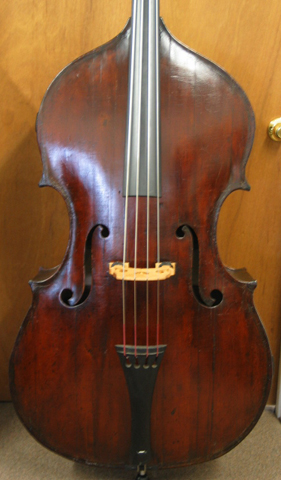 Also, the distance from the top of the Heel to the root of the Neck in the block is much less making the transition into TP so much easier. Look here between the Hart and Martini to see what I am talking about.   Playing the Bass for just a few minutes testing it you will notice other 'feel' issues than the Heel depth but playing 2-3 hour long rehearsals and concerts is another story. I end up thinking about these details on the drive home almost every time. For those of you with experience on both, which do you prefer? We talked about it awhile ago here but the Thread has all but died out.. |
|
#28
|
|||
|
|||
|
My preference is for a D neck, because it's the standard on all string instruments, and because it's stronger. An Eb neck should be installed with less overstand because the heel is much weaker. Also, to do the Eb neck right, you either need a long string length, or you need to build the bass with a short stop. Neither is a good idea, IMHO.
|
|
#29
|
||||
|
||||
|
I also feel more comfortable on the Eb neck. Maybe its because I learned on one, but when ever I play a D neck I need to check my intonation going into TP. Eb its considerably easier.
|
|
#30
|
||||
|
||||
|
Quote:
The Hart if it's overall done unintentionally just happens to be super comfortable and so easy to play up and down and across the strings. The Arch of the Fingerboard (and matching bridge) is also slightly less than the Martini and the flatter arch makes string crossings as well as left hand finger crossings a bit easier once you get used to it. The Martini is such a comfortable bass to play on as it is with the D-Neck. I can only imagine how it would feel with the same Neck and Heel as the Hart. One thing I have noticed is that the Martini has this tall Back Button that is original to the Bass and beautifully carved. The Hart has a tiny Button which helps to allow the smaller Heel. That being said, the Martini Heel at best can only be shaved down to be slightly between a D and an Eb if it were to be altered. I agree the amount of wood and neckstand of the Hart makes it weaker. I look at the bass and I can't figure out how long that Neck has been there. It also looks like the Heel was cut lower at some point but the last repair inscription before I got it was in 1944. The 3-to-4-string conversion must have been sometime in the late 19th or early 20th century or how ever old those Gears are. Like I said, the Shoulder slope is a big part of it. Maybe this new bass will transition just as easy between positions with a D-Neck as does the broader shouldered Hart with the Eb. Comparing the Hart to the Martini (my two favorite basses) you can see as well the shoulder differences. The Martini being smaller but still broad in comparison to the Bass to be copied. 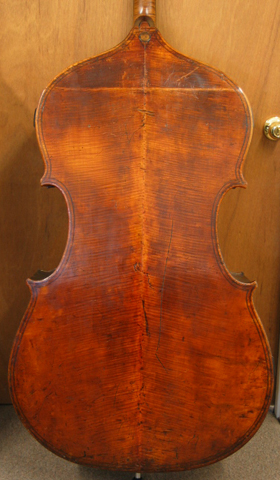 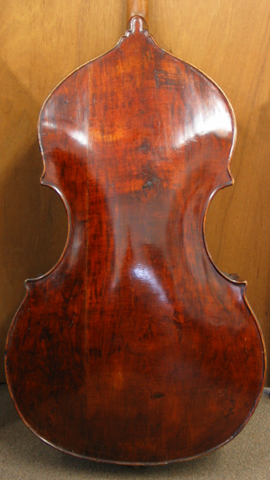   |
|
#31
|
|||
|
|||
|
All good points. Everything depends on the string length, and where the f-holes lay. On some basses, to create an Eb neck, you would have to make the string length 45"!
|
|
#32
|
||||
|
||||
|
I mentioned before that the original bass may of had one other neck graft besides the current one BUT, looking closer at the rounded button area recently we counted about 4 graft like pieces showing, maybe 5 in total. At that point we both agreed that the rounded button is more probable than not, a modification to the bass at some point in its life.
NEW: After prepping the Peg Box for the New Graft it was discovered that the latest Graft had several Shims in it that from the outside looked like other previous Grafts. This may have been done due to an ill-fitted Graft attempt or, the Graft was prepared too short and shimmed up to fill the gaps. Also, it's possible that after cutting the graft block some 30-40 years ago it was decided after to pull out some older graft pieces that were maybe not going to hold. Since no one is alive that I know of to shed light on this we can only assume. The Shims which are solid were left in and all other areas in question repaired within the pegbox. On the Purfling I have decided that copying the original Purfling in the original may not look as good on the modified copy so we will look into that when the time comes. On the original bass called a 'Storioni' I have made an announcement on my website as well as the two 'cornerless' threads that the suspected age of the original may pre-date Storioni's work period. It is now called an 18th century Italian Cornerless bass, 'ex-Riccardi' by description. One other thing that will be different between the copy and the original is the matching of the hardwoods. The original has a flamed back, burled ribs and a plain scroll, all in hard maple. The Copy will be fairly well matched flamed hard maple, Back, Ribs and Neck/Scroll alike.
__________________
Ken Smith ~ http://www.kensmithbasses.com http://www.kensmithbasses.com/doublebasses/ http://www.facebook.com/KenSmithBasses https://www.instagram.com/kensmithbasses/ https://www.facebook.com/ken.smith.904750 
Last edited by Ken Smith; 05-16-2010 at 01:59 AM. Reason: NEW: |
|
#33
|
||||
|
||||
|
Arnold and I have talked briefly about Tuners for the new Bass and to date we have not made a decision. We have considered several of the current high end tuners as well as some custom made Gears.
I would like to hear what the members here think and view your suggestions. Please be prepared on some of your choices to be 'shot down'. This is because I don't want anything too commercial looking regardles of the quality or price. Some of the gears on the market are easy to install relatively and some are very difficult to install successfully. I am confident that Arnold can tackle any type of Gear installation new or old. Some are described as PITA (pain in the A--). That being said, I want what will look best on a high class custom made modern/vintage Double bass. Installation difficulties are way down the list.. Your thoughts please? P.S.: I will be kind to those I decline and let you down easy.  These Older Gears on or off plates look and work beautifully. Since all the makers of these gears died 100-150 years ago, I would have to strip them from an existing bass. These by the way are not the easiest kind to install.  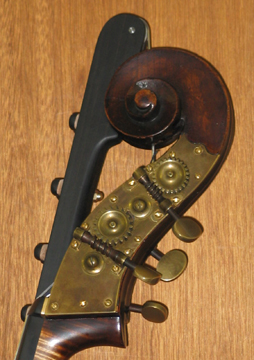  The last pic are the ones on the original bass. They are not at all original to the bass being about a century or so old and German in origin. The others are English from the 19th century. |
|
#34
|
||||
|
||||
|
Guys, here are some of the Gears I am looking at. Anyone out there have a preference?
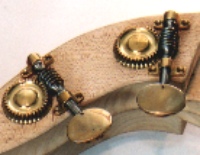 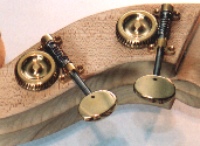 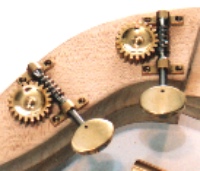 The Scroll/Pegbox is a copy of this one but slightly lengthened to handle 4 gears comfortably as this was a 3-stringer at birth..  |
|
#35
|
|||
|
|||
|
Hey Ken. I think all three of those would go amazing with that bass. I was wondering if you were getting these gears from some one else other than Gallery Strings. I recently looked into trying to get one of those same sets for my bass and was told that the only set available any more was the Baker. Which I thought was a shame since they offered such great variety and quality. Now I'm to the point of having a friend of mine who is a master, clock restorer to come up with some designs of classic sets of tuners and make them ourselves. Any feedback on this would be great. I know Arnold and Nick Lloyd have some one custom making sets for them, but they are a little out of my price range. I'm sure whatever goes on there will just add to the greatness of that beauty. Best, Adam Linz
|
|
#36
|
||||
|
||||
|
Quote:
|
|
#37
|
||||
|
||||
|
Quote:
As I mentioned before, the Copy bass will have more of a standard type Button which might keep that area a bit stronger from breaks in the future. |
|
#38
|
||||
|
||||
|
Well, since you asked, I would choose the option on the far top/left, based on appearance only.
I might also consider mass, as part of the decision. Do they all weigh the same? |
|
#39
|
||||
|
||||
|
Well, so it turns out, the ones in the middle were not available so far left is what Arnold ordered for me which by the way was my first choice anyway.
  The concern was the shorter handle because of the width of the pegbox walls but they will work just fine. The original has longer handles so I was trying to go that route. |
|
#40
|
||||
|
||||
|
I just got some pics from Arnold. The Bass is ready now for varnishing. It's all together and looks fantastic. If not for the upcoming VSA competition, it would not have been this far along considering the other work he has on the bench which includes restoring the original.
Because the bass is being entered in the competition anonymously, I can't show these in-progress pics. The label will be covered up during the judging and only uncovered afterwards. Any foreknowledge of who made what is a possible disqualification. In fact, the rules state this clearly and it's the makers responsibility to mark his work and cover his name for the judging. I do not want to be the person that let the cat out of the bag so to speak on this one. I promise that when it's all over-with, I will post all the pictures approved by both Arnold and myself. Actually, he has not had much time in the process to take pictures. He spent his time with tools in hand, not a camera. He has been going back and forth between two basses on his personal bench, the copy and the original. I will say that in advance, I am quite excited about both basses being completed. Stay tuned as this bass will be one to remember for years to come. |
 |
| Currently Active Users Viewing This Thread: 8 (0 members and 8 guests) | |
|
|